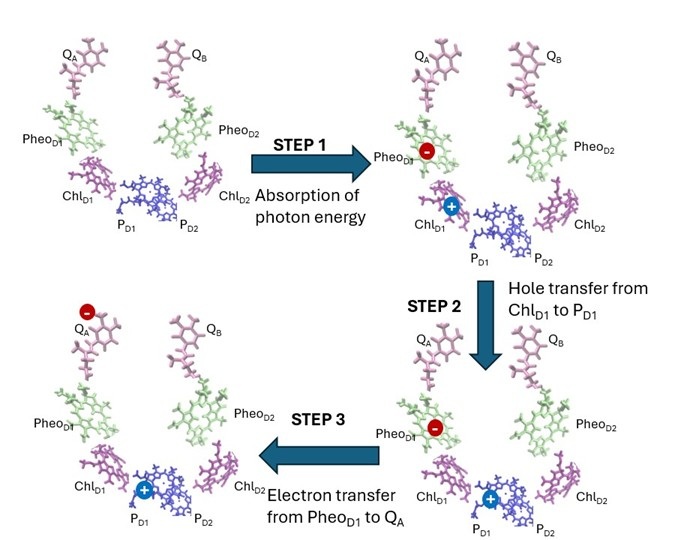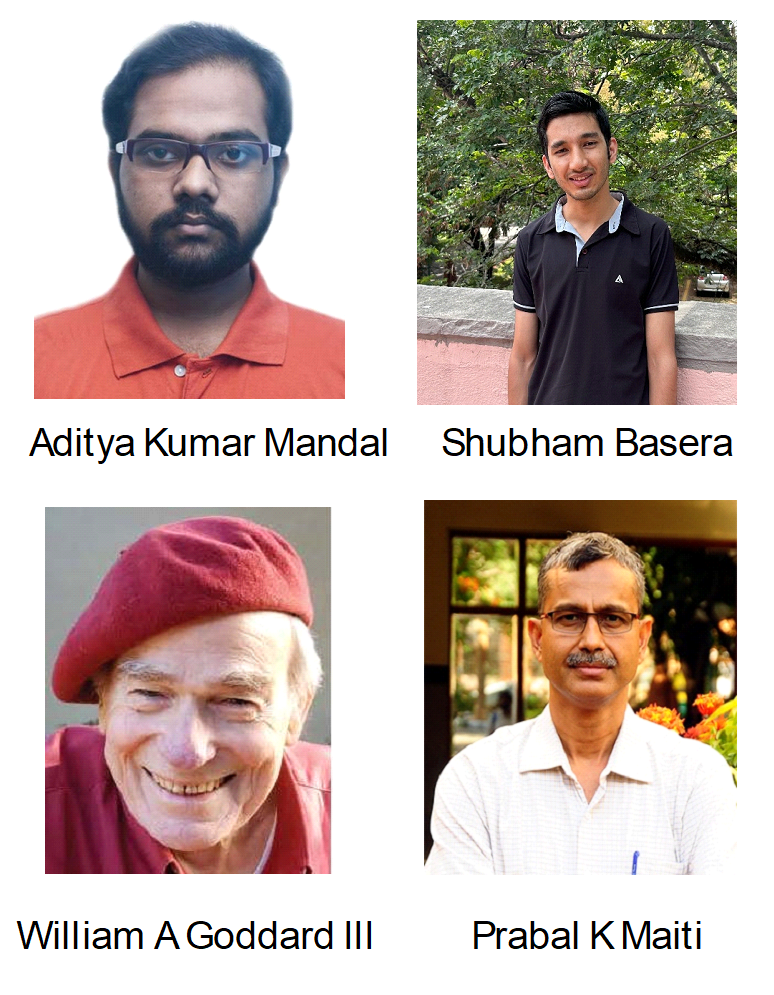16 July 2025
Researchers at the Indian Institute of Science (IISc) and the California Institute of Technology (Caltech) have solved a long-standing mystery involving the first steps of photosynthesis, the fundamental process in which plants, algae, and some bacteria trap energy from sunlight to produce oxygen and chemical energy.
The team has shown why initial electron movements that are critical for energy transfer happen across only one arm of a key protein-pigment complex. The study was published in the Proceedings of the National Academy of Sciences.
Photosynthesis involves a series of chain reactions in which electrons are transferred across multiple pigment molecules. Despite being well-studied, it is not fully understood for several reasons – the components involved are too many and too complex, energy transfer happens at ultrafast speeds, and different organisms carry it out slightly differently. Understanding these processes can help design efficient artificial leaves, fuel cells, and other systems that mimic photosynthesis.
In most organisms, a protein-pigment complex called Photosystem II (PSII) kickstarts photosynthesis by trapping energy from sunlight and splitting water, providing oxygen molecules and supplying electrons that get shuttled to subsequent proteins and molecules.
PSII contains two identical arms, called D1 and D2, around which four chlorophyll molecules and two pheophytins – pigments related to chlorophyll – are symmetrically arranged. These arms are also linked to electron-carrier molecules called plastoquinones. Electrons flow first from chlorophyll to pheophytin, then from pheophytin to plastoquinone.
But studies have shown that electrons seem to flow only along D1 – a mystery that has puzzled researchers for a long time. “Despite the structural symmetry between the D1 and D2 protein branches in PSII, only the D1 branch is functionally active,” says Aditya Kumar Mandal, first author and PhD student in the Department of Physics, IISc.
In this study, the researchers used a combination of molecular dynamics simulations, quantum mechanical calculations, and Marcus theory (a Nobel Prize-winning framework for electron transfer) to map the energy landscape for electron movement in both branches. “We assessed the electron transfer efficiency step-by-step through both D1 and D2 branches,” says Shubham Basera, PhD student in the Department of Physics and one of the authors.
The team found that the D2 branch has a much higher energy barrier, which makes electron transport energetically unfavourable. Specifically, the transfer of electrons from pheophytin to plastoquinone in D2 requires twice as much activation energy as D1 – a barrier that electrons seem unable to overcome, preventing energy from flowing forward.

Despite being symmetrical to the D1 branch, no charge transport happens along the D2 branch. The study shows that the activation barrier for the third step in D2 is nearly twice that of the corresponding step in D1 (Image: Shubham Basera)
The researchers also simulated the current-voltage characteristics of both branches and found that the resistance against electron movement in D2 was two orders of magnitude higher than that in D1.
The asymmetry in electron flow may also be influenced by subtle differences in the protein environment around the PSII and how the pigments are embedded in it, the researchers suggest. For example, the chlorophyll pigment in D1 has an excitation state at a lower energy than its D2 counterpart, suggesting that the D1 pigment has a better chance of attracting and transferring electrons.
The researchers also suggest that tweaking some of these components can boost or rewire electron flow across PSII. For example, swapping chlorophyll and pheophytin in D2 could overcome the electron block, because chlorophyll needs lower activation energy than pheophytin.
“Our research presents a significant step forward in understanding natural photosynthesis,” says Prabal K Maiti, Professor at the Department of Physics and one of the corresponding authors of the study. “These findings may help design efficient artificial photosynthetic systems capable of converting solar energy into chemical fuels, contributing to innovative and sustainable renewable energy solutions.”
This is a beautiful combination of theory at various levels to address a long-standing problem culminating in a new level of understanding, but still leaving mysteries to be challenged, says Bill Goddard, Professor at Caltech and one of the corresponding authors.

Photos of the research team
REFERENCE:
Mandal AK, Basera S, Goddard WA, Maiti PK, Unveiling the charge transport blockade in the D2 branch of the photosystem II reaction center, Proceedings of the National Academy of Sciences (2025).
https://www.pnas.org/doi/10.1073/pnas.2405023122
This work was supported by the erstwhile Science and Engineering Research Board (SERB) now Anusandhan National Research Foundation (ANRF), India, through grant CRG/2021/003659.
CONTACT:
Prabal K Maiti
Department of Physics
Indian Institute of Science (IISc)
Email: maiti@iisc.ac.in
Phone: +91-80-2293-2865
Website: https://physics.iisc.ac.in/~maiti/
William A Goddard III
Charles and Mary Ferkel Professor of Chemistry, Materials Science, and Applied Physics
Director, Materials and Process Simulation Center (MSC)
California Institute of Technology
Email: wag@caltech.edu
NOTE TO JOURNALISTS:
a) If any of the text in this release is reproduced verbatim, please credit the IISc press release.
b) For any queries about IISc press releases, please write to news@iisc.ac.in or pro@iisc.ac.in.



